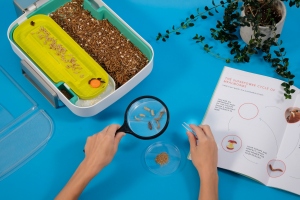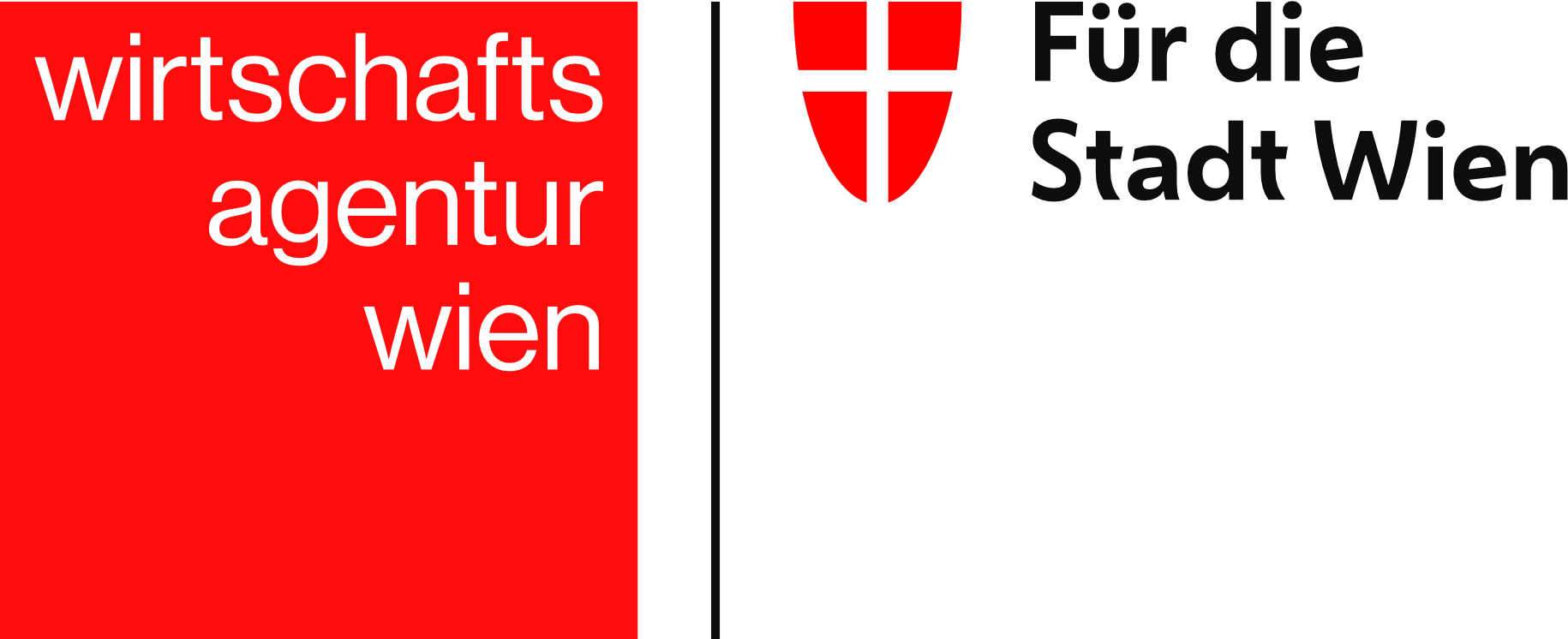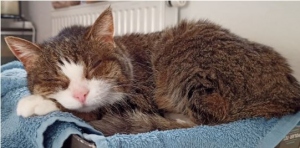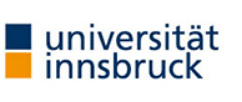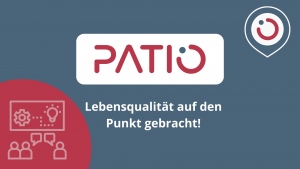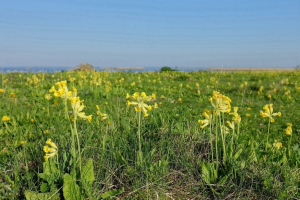
Florian Heigl
Explorer Challenge
The Austrian start-up Livin Farms develops innovative technologies for the sustainable breeding of insects. Food and other organic residues can be recycled with the help of insects and converted back into valuable proteins. In this way, cycles can be closed and food systems can be made more sustainable.
Explorer Challenge
Education is another central aspect at Livin Farms. As part of the Explorer Challenge school project Livin Farms brings sustainability, circular economy and insects to schools. The project is for public secondary schools in Vienna and runs in cooperation with the Vienna Business Agency. Participation in the project is free.
School classes receive up to 3 Hive Explorer (mini mealworm farms) per school for up to one semester. Participating school classes develop their own research questions on insects and insect breeding and implement experiments to find answers. The results are documented and presented.
Through the participation of the students as Citizen Scientists, new research questions are developed. Thereby new knowledge and new insights are generated and research on the subject of insects as an alternative source of protein is supported.
Other schools are also invited to participate. To receive a Hive Explorer, these schools can check the website www.thehiveexplorer.com or send an to email This email address is being protected from spambots. You need JavaScript enabled to view it..
Picture Gallery
-
 Hive Explorer in Vienna Open Lab 2 (c) Vienna Open Lab Hive Explorer in Vienna Open Lab 2 (c) Vienna Open Lab
Hive Explorer in Vienna Open Lab 2 (c) Vienna Open Lab Hive Explorer in Vienna Open Lab 2 (c) Vienna Open Lab -
 Hive Explorer in Vienna Open Lab (c) Vienna Open Lab Hive Explorer in Vienna Open Lab (c) Vienna Open Lab
Hive Explorer in Vienna Open Lab (c) Vienna Open Lab Hive Explorer in Vienna Open Lab (c) Vienna Open Lab -
 Hive Explorer in the NMS Konstanziagasse 2 (c) livin farms Hive Explorer in the NMS Konstanziagasse 2 (c) livin farms
Hive Explorer in the NMS Konstanziagasse 2 (c) livin farms Hive Explorer in the NMS Konstanziagasse 2 (c) livin farms -
 Hive Explorer in the NMS Konstanziagasse (c) livin farms Hive Explorer in the NMS Konstanziagasse (c) livin farms
Hive Explorer in the NMS Konstanziagasse (c) livin farms Hive Explorer in the NMS Konstanziagasse (c) livin farms -
 Hive Explorer in the OMS Pfeilgasse (c) livin farms Hive Explorer in the OMS Pfeilgasse (c) livin farms
Hive Explorer in the OMS Pfeilgasse (c) livin farms Hive Explorer in the OMS Pfeilgasse (c) livin farms
https://www.citizen-science.at/en/component/k2/author/934-florianheigl?start=100#sigProIdd040d396ee
This project fulfilled version 1.1 of the quality criteria for citizen science projects on Österreich forscht.
Cats do science
1. Description
Take part in a Citizen Science Project, in which your cat will play the main role! According to current knowledge, any kind of damage or addiction to catnip can be ruled out – the administration of catnip to the cat is completely harmless. The experiment requires about 20 minutes a day for three days in a row (preparation time is included). At the end of the experiment, a total of 15 minutes of recordings should result.
2. General
Dear Citizen Scientists!
First of all, thanks to all of you who decided to participate in a Citizen Science Project. The favourite domestic animal of Austrians and Germans are cats. They can be encountered in about 16% of Austrian household, which makes up every 6th household with a feline. You must’ve already heard about how cats go crazy about catnip (Nepeta cataria) that has been named after them. Reports on their reactions to the herb vary a lot: some show little or no interest at all, whereas others enjoy every touch or even fall into a state of euphoria. Researchers all over the world are eager to know why cats in particular cannot resist the scent of catnip, and initial finding are emerging.
Important: There are no reports or indications about catnip being harmful to your cat.
Furthermore, there are still many unanswered questions. The questions that I’ve been asking myself are whether cats can develop a resistance to catnip and whether distinguishing features such as gender, genetics or age have any influence on the development of resistance. At a regular consumption of various intoxicants and stimulants, humans must take a higher dose of a substance to achieve the same effect, or in other words: the effect diminishes if the amount of a substance remains the same. Together with my master thesis and you participating, I want to examine this hypothesis and create findings. For this, please read through the following points.
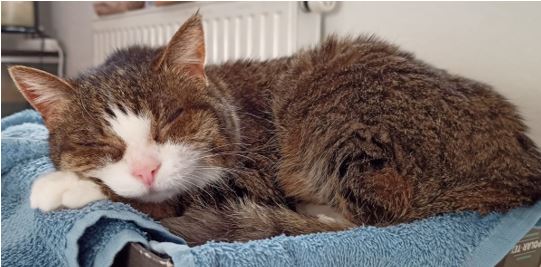
3. Preparation and instructions
- The experiment requires 20 minutes each of three consecutive days. The time for the experiment for the participant is free to be chosen, however, the continuation on the following days should be carried out roughly at the same time as on the first day (± 1 hour).
- The contents of the test kit
- information sheet
- questionnaire with an assignment code of six digits on the backside
- five sacks of catnip (about 9g each) (be careful when taking out the sacks – they are not sealed)
- a cotton bag
- One test kit is to be used for one cat. During the administration of catnip to the cat, the feline mustn’t have any contact to other cats.
Note that only three out of five sacks with catnip are needed. The other two are meant as a small token of attention to you and for personal use. Should your cat show no interest in the catnip, you could use the herb for tee as well.
4. Allocation of tasks
The tasks of the citizen scientist consist of preparing and recording the experiment, and filling out the questionnaire. For the preparation: according to instructions, stuff one sack of catnip into the cotton bag and lace it up. Administer the bag to the cat by either placing the bag in front of the feline or bringing the feline directly to the bag. Now, start recording by showing the administration code first, then the cat according to chapter 5 “Performing the experiment”.
Upload the videos to the upload link (to be found in the second e-mail) and fill out the questionnaire online. Every video and completed questionnaire will then be analysed to see whether changes of behaviour throughout the experiment appear and whether estimations on the cats’ behaviour can be made based on distinguishing features such as gender, genetics, age, etc. Besides, the hypothesis that none or barely interested cats can learn to react to catnip by the administration is to be examined as well.
5. Performing the experiment
In order to carry out the experiment, a smart device (e.g., smartphones, tablets, etc.) or a video camera are required for recording. Then, a total of 16 minutes is needed for the performing.
Step 1: Stuff one of the sacks with catnip into the cotton bag.
Step 2: Start recording. Briefly and discernibly, show the administration code on the backside of the questionnaire. Start a stopwatch or note the time when administrating the cotton bag to the cat (t0) and record the cat’s reaction for two minutes. Interact with the feline as little as possible after starting the experiment.
Step 3: Five minutes after the administration (t5), record the cat’s reaction for one minute.
Step 4: Ten minutes after the administration (t10), record the cat’s reaction for one minute.
Step 5: 15 minutes after the administration (t15), record the cat’s reaction for one minute.
- Find an instruction video on the homepage of the faculty of zoology (link located further below).
- The last page of this project description shows a pictorial instruction.
- A total of five minutes video material should result per day – 15 minutes for the entire experiment over three days.
- Should the cat lose interest, please note the precise time (tx) at which the cat shows no more response.
- Should the cat show no interest in the catnip at all, note that as well, as that counts as a result too. If no interest is shown, no recordings are needed.
- Change or clean the location after the first and second day of administration. That ensures best condition, without influences of the day before.
- During the 16 minutes of administration, do not give the cat any kind of treats or titbits, otherwise, feed the cat as usually.
- Find the administration code that is assigned to one cat only on the backside of the questionnaire.
- The first video of each day should include a brief recording of the code right at the beginning; the recording of the code should not be a separate video.
- The chronological order of the videos should evidently be named automatically by your smart device. Naturally, you can rename the videos as long as the date and time are made clear.
- In a second e-mail, find a link for the video uploads and a link for the digital questionnaire.
- The digital questionnaire corresponds to the questionnaire in the test kit that serves only for personal notetaking for the duration of the experiment. Should any problem arise when filling out the online questionnaire, please send us the completed questionnaire per e-mail.
- For further questions regarding the upload, experiment or any problems, feel free to contact me at This email address is being protected from spambots. You need JavaScript enabled to view it..
- The uploaded videos cannot be watched by other participants due to data protection!
6. Purpose of the experiment
The purpose of the experiment is to observe and examine how cats’ behaviour might change or diminish if they are exposed to catnip for three consecutive days. The more participants we have, the more significant are the results.
7. Contents of the test kit
The catnip used for this Citizen Science Project comes from barryz.de, based in Germany. To this grown in France catnip we attach great value – meaning, it is grown naturally and it contains no artificial colouring, preservatives and is completely GM-free (not genetically engineered). Besides, the catnip is fully vegan and gluten free. The five sacks with the catnip of the brand Cilia are made of pure paper fibres, the cotton bag of the brand SAKETOS consists of 100% cotton. The test kit does not contain anything that could harm you or your cat.
8. Related links
For more information on this project, please visit the project homepage of the faculty of zoology at the university of Innsbruck.
Otherwise, feel free to watch our YouTube video.
If you have any further questions, please do not hesitate to contact us: This email address is being protected from spambots. You need JavaScript enabled to view it.
I wish you and your cat a lot of fun with the experiments!
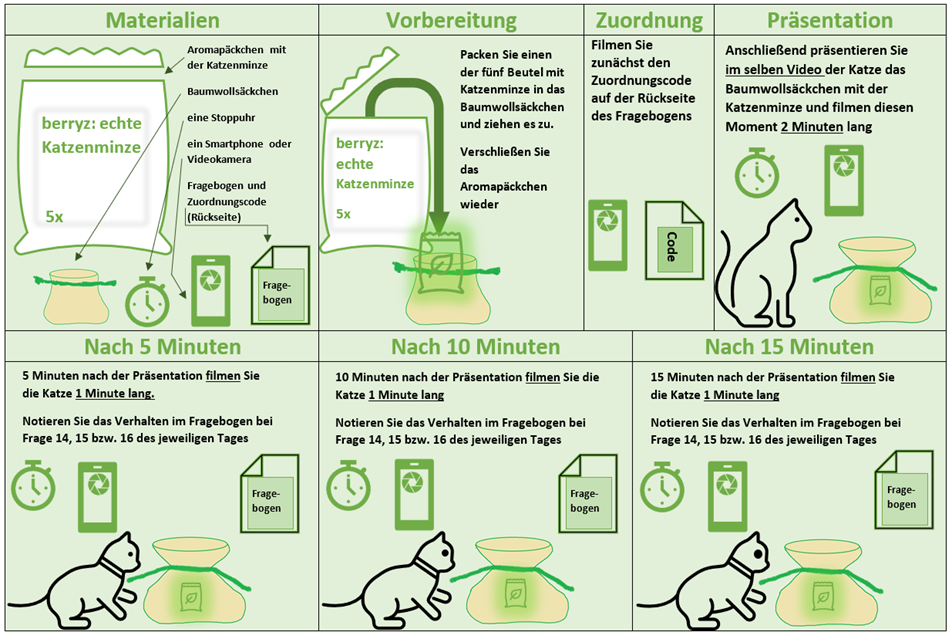
Picture Gallery
-
 Relaxation Relaxation
Relaxation Relaxation -
 Contact Contact
Contact Contact -
 Packing Packing
Packing Packing -
 Smell Smell
Smell Smell -
 Working process aroma bags Working process aroma bags
Working process aroma bags Working process aroma bags -
 Working process teabags Working process teabags
Working process teabags Working process teabags -
 aroma bags aroma bags
aroma bags aroma bags -
 Catnip Catnip
Catnip Catnip
https://www.citizen-science.at/en/component/k2/author/934-florianheigl?start=100#sigProId6b6bde7bd2
This project fulfilled version 1.1 of the quality criteria for citizen science projects on Österreich forscht.
PATIO - Patient Involvement in Oncology
Be an expert on your disease and join our research!
The PATIO initiative is working hard to strengthen the voices of prostate cancer patients and their caregivers heard in medical research.
Why is it important to act now?
Porstate cancer affects a considerable number of people in Austria. On the one hand, around 65,000 men have suffered from this particular type of cancer by the end of 2020 (Statistics Austria, 2022), and on the other hand, there are countless partners, children, grandchildren and close friends who stand by the side of those directly affected by the disease. Over time, caregivers acquire more and more knowledge about prostate cancer and thus become valuable mediators of the everyday life with the disease and the corresponding research.
Our aim is to make everyday life with prostate cancer easier for those affected by the disease with the help of a digital communication tool.
Being disgnosed with "cancer" is a dramatic experience and prostate cancer is likely to be a challenging disease both during and after treatment. In addition to the physical effects, the disease can also affect your personal relationships, hobbies, work life and financial situation. It is your individual strategies for coping with the side effects of cancer that can be extremely valuable not only to other people affected by cancer, but also to research!
This is where the PATIO initiative comes in. Since 2020, we have been working closely with a total of nine patients and one patient's relative to improve the overall quality of life. We want to learn from their personal stories and experiences. Together, we want to find ways to improve everyday life with prostate cancer for everyone involved.
“PATIOSpots” as a result of direct public participation and engagement
The “PATIOSpots” health guide app was developed in a co-design and co-creation process with people affected. It allows users to find various relevant contact points on a worldwide map or to enter them themselves in a participatory way. Points of contact can be, for example, toilets, treatment centres, support groups, medical supply shops, etc. Other features can also be added to the locations (opening hours, cleanliness, facilities, etc.). The app is also directly linked to our website www.patiospots.com. Articles on current scientific issues and everyday life with prostate cancer are also regularly published here. Our "PATIO Lounge" forum is another networking platform where people can exchange views on various topics.
PATIO's vision is to provide the best possible information on treatment options and advice on how to manage the symptoms of the disease, but also to provide a communication platform for internal exchange and an interface between doctors and patients.
The initiative
The PATIO initiative is a collaborative research project that brings together scientific knowledge from different disciplines and the practical expertise of prostate cancer patients in Austria. The project is being carried out at the Medical University of Vienna in collaboration with scientists from academia as well as with the official support group for prostate cancer in Austria. Nine patients and one relative contribute their knowledge and life experience to the extended team. The project was funded by the Open Innovation in Science Center of the Ludwig Boltzmann Society.
Stay up to date
You just found out about “PATIO” by this posting and would like to stay informed about the next steps we are taking altogether at “PATIO”? We heartly invite you to sign up for our newsletter and to follow us on TikTok, Facebook and Instagram.
Gallery
-
 1. Round table 1. Round table
1. Round table 1. Round table -
 1. Round table 1. Round table
1. Round table 1. Round table -
 1. Round table 1. Round table
1. Round table 1. Round table -
 1. Round table 1. Round table
1. Round table 1. Round table -
 We keep the patient experience high! We keep the patient experience high!
We keep the patient experience high! We keep the patient experience high! -
 Round table - we are complete Round table - we are complete
Round table - we are complete Round table - we are complete -
 Round table Round table
Round table Round table -

-

https://www.citizen-science.at/en/component/k2/author/934-florianheigl?start=100#sigProId7f230eb5a6
This project fulfils version 1.1 of the quality criteria for citizen science projects on Österreich forscht.
Hungarian Bumblebee
The "Österreichische Vogelwarte" reports that the Hungarian Bumblebee (Bombus haematurus) has now been sighted in Lower Austria: https://www.citizen-science.at/blog/ungarische-hummel-in-niederoesterreich-gesichtet
Blog Abo
Did you know that you can subscribe to our blog and be automatically informed about new posts? You can find out how here: https://www.citizen-science.at/blog/willkommen-am-blog-von-oesterreich-forscht
DeVOTE
DeVOTE is a research project funded by the European Research Council (ERC) from January 2021 to December 2025, and led by Ass.-Prof. Carolina Plescia to develop and apply a new approach to study what ‘voting’ means for ordinary citizens. The project’s goals are:
- understand what ‘voting’ means for ordinary citizens;
- examine the variation of 'voting' meanings across individuals and across countries;
- study how elections create and modify these 'voting' meanings;
- investigate the consequences of 'voting' meanings for citizens' preferences, attitudes and their political behaviours;
- devise an election 'observatory' for systematic data collection on the meanings of voting on Election Day that can favour the scientific interpretation of election outcomes.
Why does this matter?
The question what is the meaning of voting is of great importance today due to the growing distrust in the act of voting itself and in democratic institutions in many countries around the world. The DeVOTE project investigates the political, symbolic and psychological meanings of voting. What does voting mean to you? Is voting a civic duty? Is there a political alternative to voting?
Using a novel methodological approach, a new typology of meanings and motivations for voting will be developed. Through the practice-oriented analysis of elections, the project offers an important source of information on the political significance that citizens attach to elections and the act of voting. The project does not only focus on the already well-researched countries in Western Europe, but also looks at the so-called autocracies in Europe and beyond. This allows new insights into voting outside of democratic systems.
DeVOTE is committed to open science practices, aiming to make multilingual scientific knowledge openly available, accessible and reusable for everyone. This is done in compliance with GDPR standards to protect your privacy.
How can you participate?
DeVOTE invites you to participate by sharing your own meanings of voting and help us explore the diversity, change and use of all possible meanings of voting in your own country and beyond. Participation is possible via an online form on the project website. There are various ways you can take part in DeVOTE:
| 1. Your opinion matters → DEFINE VOTING! You can write down terms and descriptions for your own definition of voting answering the question “What does voting mean to you?” | |
 |
| 2. You are the observer → IMAGINE DEFINITIONS! You can tell us where your definition of voting comes from. |
 |
| 3. You are the researcher → COLLECT DATA! You can search for the many possible definitions that journalists, parties, politicians, stakeholders and so on give to voting and describe them. |
 |
| 4. You are the expert → CATEGORIZE MEANINGS! You can provide direct input to the researchers in DeVOTE by categorizing the meanings of voting we have collected. |
This project fulfils version 1.1 of the quality criteria for citizen science projects on Österreich forscht.
Biodiversity at cemeteries
Since April 2021, the BaF-Biodiversität am Friedhof project has been researching biodiversity in Austrian cemeteries in collaboration with Friedhöfe Wien GmbH, with a special focus on Vienna's cemeteries. The aim is to document biodiversity and analyse the impact of human activities on these urban habitats. This close cooperation between BOKU and urban cemeteries enables a deep understanding of the diverse ecosystems and supports the development of sustainable measures to protect and promote biodiversity. The BaF project thus makes a significant contribution to scientific research and the sustainable development of urban green spaces.
Cemeteries as biodiversity hotspots - project goals & participation
Cemeteries are more than just places of mourning and remembrance. Due to their location, size and the various natural areas they harbour, they represent an important habitat for a variety of organisms. But exactly how many creatures live in cemetery areas has not yet been researched. The BaF Biodiversity at Cemeteries project aims to carry out a comprehensive inventory of biodiversity in Austrian cemeteries and invites you to become part of this exciting research project and discover the fascinating world of cemetery nature.
Why is research into biodiversity in cemeteries so important? Quite simply! Because such an inventory not only allows conclusions to be drawn about changes in biodiversity, but also provides insights into the coexistence of humans and nature. By collecting data on the various plant and animal species, important insights can be gained into how human activities affect the environment and what measures can be taken to protect biodiversity. Together with volunteers and experts from a wide range of fields, various methods are used to record biodiversity, including counting and identifying plant and animal species, carrying out mapping and creating biotope maps.
Join in and help us unravel the secrets of cemetery nature! Every contribution counts and helps us to better understand and protect our environment. More information at: baf-austria.at.
This is how it works:
1) Discover plants, animals or fungi at the cemetery site.
2) Send us a photo or your report to This email address is being protected from spambots. You need JavaScript enabled to view it. or use the sighting form on our website.
3) Give us information about time and place of your sighting.
4) We help with determinations and you help to protect the biodiversity of our city!
Podcast episode
For our "Wissen macht Leute" anniversary edition in November 2025, we interviewed project manager Thomas Filek at Meidling Cemetery. Listen to it here! (in German)
Citizen Science Seminar
In 2024, poject coordinator Thomas Filek held a lecture as part of the lecture series "Citizen Science Seminar" at BOKU University: "Biodiversity at Cemeteries - a look at three years of sustainable developments" (in German).
The team and the organisation
BaF consists of a small team of student assistants, lecturers and of course you. Project leader is Thomas Filek, who, in addition to the organisation, also takes care of the staff and the dialogue with you.
Partners
Image gallery
Click on an image to enlarge it.
-
 Chrysis ignita (Martina Konecny - BaF) Chrysis ignita (Martina Konecny - BaF)
Chrysis ignita (Martina Konecny - BaF) Chrysis ignita (Martina Konecny - BaF) -
 Cricetus cricetus (Martina Konecny - BaF) Cricetus cricetus (Martina Konecny - BaF)
Cricetus cricetus (Martina Konecny - BaF) Cricetus cricetus (Martina Konecny - BaF) -
 Corvus cornix (Martina Konecny - BaF) Corvus cornix (Martina Konecny - BaF)
Corvus cornix (Martina Konecny - BaF) Corvus cornix (Martina Konecny - BaF) -
 Capreolus capreolus (Martina Konecny - BaF) Capreolus capreolus (Martina Konecny - BaF)
Capreolus capreolus (Martina Konecny - BaF) Capreolus capreolus (Martina Konecny - BaF) -
 Falco tinnunculus (Martina Konecny - BaF) Falco tinnunculus (Martina Konecny - BaF)
Falco tinnunculus (Martina Konecny - BaF) Falco tinnunculus (Martina Konecny - BaF)
https://www.citizen-science.at/en/component/k2/author/934-florianheigl?start=100#sigProIdc52251ff0a
Video
This project fulfils version 1.1 of the quality criteria for citizen science projects on Österreich forscht.
Blog Abo
By the way, you can also subscribe to our blog so that you no longer miss any news. To do so, simply register and click on the envelope at the top right corner of this link https://www.citizen-science.at/blog
Ideenbox (Box of Ideas)
The Ideenbox (box of ideas) collects the problems of citizens and patients around the topic of health (such as physical and mental health issues, social consequences, care, health prevention...), for which solutions are to be developed with citizens, researchers and other stakeholders. Which health problem do you want research to solve? Who should be involved in finding a solution? Send us the health problem that you would like research to address through this simple online questionnaire (in German). The contribution does not have to include a solution, only the problem itself, which can address a personal or a general/societal concern.
See an example of a problem in the video below. In our YouTube playlist you can find more example videos.
Why are citizens’ health experiences important for research?
In some way we all research our own health: we learn which tea soothes the intestines and observe which pollen makes our eyes cry. All this information and knowledge come together in our personal reference book. We aim to enable the involvement of this expertise from people who are interested in or are facing problems related to health. By doing so, we not only try to make health research more democratic - we also hope to ensure that valuable knowledge from people with lived experience is not lost.
Why should I participate?
Because you have something to say and you know something that experts potentially do not know. You have your own experiences and observations that are extremely valuable for research. The Ideenbox gives you the opportunity to share your observations with experts in order to develop relevant recommendations for action and new research topics.
What happens after I have submitted my health problem?
With your consent, we will publish your contribution on the Open Knowledge Map platform from autumn 2021 onwards, thus making the contributions visible. We will also actively promote the published contributions in a larger community of different stakeholders. In addition, we offer you the option of publishing your contact details in pseudonymised form on the Ideenbox Knowledge Map. This allows researchers and other stakeholders to contact you (e.g. to learn more about your problem) without them first receiving your contact details or being able to establish your identity. Interested parties will only receive your contact details if you respond to their request. Further details on data protection can be found on pur project website. If you have any questions about data protection or other issues, you can write to us at This email address is being protected from spambots. You need JavaScript enabled to view it..
After the collection phase, participating citizens will evaluate the contributions together with researchers and edit them in workshops around spring 2022, to find solutions to the problems. All relevant stakeholders (depending on the problem i.e. health practitioners, teachers, social workers, psychologists…) will also be involved in this process. Therefore, when you submit your contribution you have the possibility to choose to remain in contact with us, so that we can keep you informed about the project results and invite you to the workshops. This should enable networking between society and science.
Who is behind the project?
The project is managed by the Open Innovation in Science Center (OIS Center) of the Ludwig Boltzmann Gesellschaft (LBG). The LBG is a recognised non-university Austrian research institution that operates 20 institutes, with a thematic focus on medicine and life sciences as well as the humanities, social and cultural sciences. The LBG specifically initiates new research topics in Austria and develops and tests new forms of cooperations between science and non-academic actors such as the public sector and civil society.
The OIS Center acts as a competence centre for this approach. The Center has already successfully handled a mental health campaign with the involvement of patients and citizens and has transformed their problems into institutional research.
This project fulfils version 1.1 of the quality criteria for citizen science projects on Österreich forscht.
Looking for Cowslips
In spring, scientists invite everybody around Europe to take part in the biggest cowslip observation campaign “Looking for Cowslips”. The aim of the project is to examine the patterns of flower morphological traits (i. e. heterostyly) in cowslip populations all across Europe using a citizen science approach. The citizen science project “Looking for Cowslips” was carried out already in 2019 and 2020 in Estonia and Latvia. Within the frames of this campaign, we obtained heterostyly data from > 150 000 cowslip individuals in each year of 2019 and 2020 in Estonia (and Latvia). Since 2021 we are also asking enthusiastic citizen scientists across the EU to participate and contribute, with great success. Data originating from the campaign provides unprecedented insight into the patterns of heterostyly following the loss of semi-natural grasslands.
Participants are expected to observe the patterns of heterostyly in cowslips. The cowslip (Primula veris) is a heterostylous plant – it means that the plant can have one of the two types of flowers. These different types of flowers are called S-morphs (short-styled) and L-morphs (long-styled). In short-styled cowslips (S-morphs), five anthers are visible in the flower when looking from above, and in individuals with L-type flowers, a green dot in the middle of the flower (the stigma) is visible. Normally in cowslip populations, the frequency of these different types of individuals is more or less equal. Imbalance reduces a plants’ opportunities to find a suitable mate for reproduction, which impedes pollination and the exchange of genetic material. This, in turn, reduces a plants’ vitality. The cowslip’s regular habitats – traditionally managed grasslands – have become increasingly rare in the contemporary landscape. The disappearance of grasslands causes decline in plant populations depending on grassland habitats. A massive decline in cowslip populations can cause substantial imbalances in the frequency of L- and S-morphs to the extent that one of those types completely disappears from the habitat. That is precisely the kind of a possible shift in the balance between the L- and S-morphs caused by changes in the landscape that we want to study – with your help. An observation takes about 30 minutes. When possible, one should observe the flowers of 100 cowslip individuals. Look at the flower and report whether you see five anthers (S-morph) or one stigma (L-morph). Find the time, breathe some fresh air, and help scientists with their work!
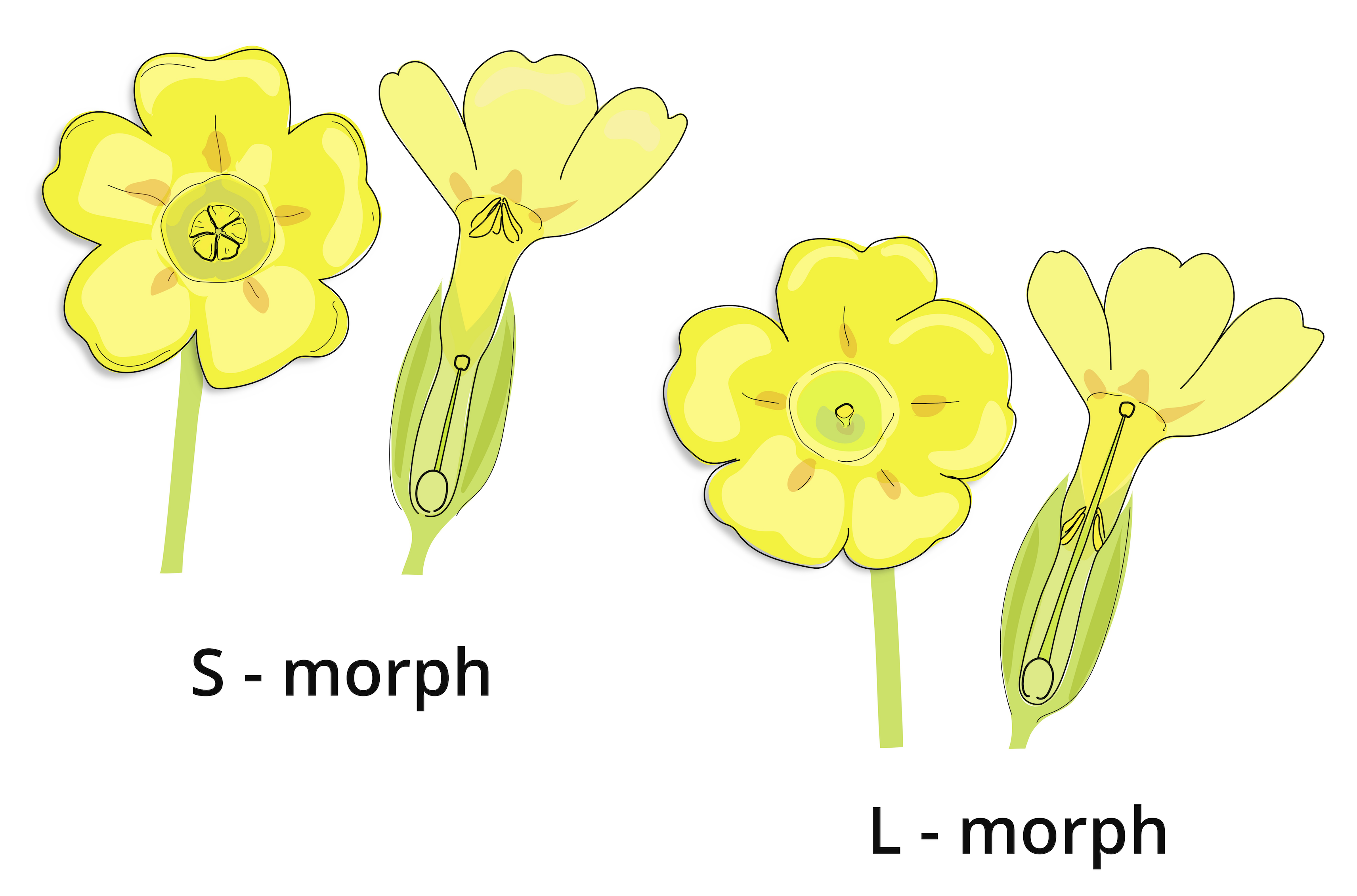
For more information, check out our webpage www.cowslip.science.
To find out more about the interesting findings from the first year of the campaign, you can read the article at: https://besjournals.onlinelibrary.wiley.com/doi/full/10.1111/1365-2745.13488.
You can contact us at This email address is being protected from spambots. You need JavaScript enabled to view it. for further questions.
This project fulfils version 1.1 of the quality criteria for citizen science projects on Österreich forscht.

